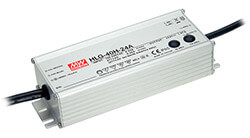Calculating Power Consumption
The illuminated sign energy consumption and cost calculation is simple yet confusing when you have to consider such things as power factor correction, ballast factor and efficiency of typical power conversion devices used in today’s illuminated signs.
In light of this, how do you determine power consumption of electrical equipment of a sign?
Let’s understand the basics before we look at the mathematics involved!

Electrical Calculation
The basic unit of measure for electric power is the watt. Since the number of watts measured over a period of time (by hours) can accumulate into the tens of thousands, energy consumption is measured in kilowatt-hours – one kilowatt (1kW) is equal to 1,000 watts. For one kilowatt-hour (kWh) of electrical energy to be consumed then one kilowatt of electricity must have been flowing for one hour (or, two kilowatts of electricity flowing for one half hour).
For example, a 1,000-watt light bulb turned on for one hour consumes 1kWh of electricity; ten 100-watt light bulbs turned on for one hour would also consume 1kWh of electricity. The cost of energy consumption use is equal to the total kWh consumed over a period of time multiplied by the local energy rate, expressed as cents or dollars per kWh ($/kWh).
Approximating Energy Consumption
To approximate energy consumption for your electrical equipment or sign, you must determine the total wattage. You can do this by reading the labels of all components, such as the ballast, neon supply, or the LED supply used in the sign. The wattage will most likely be stamped on the nameplate of each of these components. In some cases, the wattage requirements may not be shown on these components — only amps and volts. The amp requirement is usually stamped on the nameplate of the component. You approximate the wattage simply by multiplying the amps by the volts. However, to determine exact wattage you need to multiply amps by the volts and by the power factor. If power factor is not marked on the product label then you need to review the datasheet or call the manufacturer.
Add up all the wattage of these components, then divide the total wattage by 1,000 to obtain the kilowatts. Multiply this by the number of hours the equipment is in operation and then by the energy cost rate per kWh in your area. To help you determine the energy cost rate in your area just look at your last power bill from your power service provider This will give you the operating cost.
In short, the cost of operation per month will equal total watts being drawn by the equipment divided by 1,000, times the hours used per month times the cost per kWh.
All ballasts actually consume energy within themselves while driving lamps. So, the total energy (watts) being drawn from the line is the total of the energy consumed by the ballast plus the energy used by the fluorescent or HID lamp. This additional energy consumption can range from 1 percent to 25 percent of the total kWh. Solid-state electronic ballasts consume minimal additional energy to energize the ballast, whereas older magnetic ballasts may require up to 25 percent additional energy to energize the ballast. Neon supplies and LED supplies also fall into the same category unless provided with power factor correction circuitry. Since incandescent bulbs do not require a ballast no additional energy is needed to drive the bulbs. For details, always consult the manufacturer’s specifications to determine input requirements for these components.
Lighting Formulas
Incandescent Lighting: Watts* X hours per day = watt-hours per day; X days per year = watt-hours per year; ÷ 1,000 = kWh per year; X energy cost per kWh = total annual energy cost.
Fluorescent and HID Lighting: Watts* X hours per day = watt-hours per day; X days per year = watt-hours per year; ÷ 1,000 = kWh per year. Total kWh per year X energy cost per kWh = total annual energy cost.
* Total wattage for all energy consuming devices in a sign
Here are some examples on how to calculate per-year energy-use costs for a medium size sign:
Example 1:
Assumptions–A sign built with eight fluorescent 40-watt lamps remains on for 10 hours a day, 365 days per year, and the energy use cost per kWh is 19 cents.
The calculation–8 lamps X 40 watts each = 320 watts; divided by 1,000 = 0.32 kilowatts; multiplied by 10 hours = 3.2 kWh; multiplied by $0.19 = $0.61 per day; multiplied by 365 days = $221.92 per year. If the sign ballast were the magnetic type, then the per-year cost = 3.2 X 365 X 1.15 X 0.19 = $255.21
Example 2:
Assumptions–A neon sign built with two neon transformers operating at 85 percent of rated load yielding primary VA of 225, remains on for 10 hours a day, 365 days a year, and the energy cost is 19 cents. The nameplate ratings are: 120V, 2A, 0.5PF.
The calculation–2 transformers X 225 watts X 0.5 each = 225 watts; divided by 1000 = 0.225 kilowatts; multiplied by 10 hours = 2.25 kWh; multiplied by $0.19 = $0.4275 per day; multiplied by 365 days = $156.04 per year. Based on the nameplate ratings, the per-year cost = (120 X 2 X .5 X 2 / 1000) X 10 = 2.4 X 365 X 0.19 = $166.44
Example 3:
Assumptions–A channel letter sign built with 100 LED modules rated 0.5 watts each, operated with two power supplies, remains on for 10 hours a day, 365 days a year, and the energy cost is 19 cents. The nameplate ratings of power supply are: input 120V, 30W, efficiency 84 percent; output 12VDC, 25W.
The calculation–As the efficiency of the power supply is 84 percent, and each power supply is driving 50 LED modules of 0.5 watts each, that amounts to 50 X 0.5 = 25 watts, which is equal to output ratings of the power supply. Considering the 85 percent efficiency, the input wattage is: 25/0.84 = 30 watts. Therefore, for the entire sign, the annual energy use cost is: 2 X 30 watts each = 60 watts; divided by 1,000 = 0.06 kilowatts; multiplied by 10 hours = 0.6 kWh; multiplied by $0.19 = $0.114 per day; multiplied by 365 days = $41.61
The numbers for these examples are arbitrary, but are close to real-life situations. However, they should not be considered as final. For each sign, you should use one of the applicable examples and plug in the correct numbers for that sign to accurately calculate the sign energy consumption us



